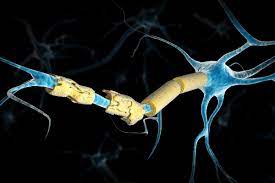Researchers in the United States recently investigated the link between multiple sclerosis (MS) and the Epstein-Barr virus (EBV).
Their result suggests that contracting EBV increases the risk of developing MS by 32-fold.
The result also suggests that therapeutically targeting EBV may become a beneficial new strategy in preventing and treating MS.
MS is a potentially disabling condition that affects the brain, spinal cord, and optic nerves. Its symptoms vary from mild, such as blurry vision, to severe, such as paralysis or problems with mobility.
In MS, the immune system attacks the brain and spinal cord, resulting in damages to the myelin sheath. The myelin sheath is a protective layer covering the brain nerves responsible for transmitting signals to and from the brain. Consequently, damage to the myelin sheath interrupts the brain’s communication signals.
The exact reason why the immune system attacks the brain and spinal cord in MS is unknown.
However, most experts suggest that a combination of factors plays a role in the process.
In a first-of-its-kind study, researchers in the United States recently determined that contracting EBV, a common virus, significantly increases the risk of developing MS.
“Our study is the first that provides compelling evidence of causality, i.e., it suggests that EBV is the leading cause of MS,” Dr. Kjetil Bjornevik, M.D., first author of the study, explains.
Dr. Bjornevik is a research fellow at the Harvard T.H. Chan School of Public Health in Boston, MA.
“We found that EBV-infection was associated with a 32-fold increased risk in MS,” he said, noting that “a risk of this magnitude is unusual in scientific research.”
The study results appear in the journal Science.
A 20-year sample size
The study involved a cohort of active-duty U.S. military personnel monitored between 1993 to 2013.
The researchers examined blood samples collected from more than 10 million individuals over 2 decades to observe the incidence of MS among a group of EBV-negative individuals.
The team monitored the EBV status of the study participants at the time of first sample collection and the relationship between EBV infection and the development of MS.
They discovered about 955 cases of MS among active-duty personnel.
For each identified case of MS, the researchers matched two randomly selected individuals without MS — of the same age, sex, race or ethnicity, branch of military service, and dates of blood samples collection — who were on active duty at the time of diagnosis.
This group served as the control.
In addition, the research team requested aliquots of three serum samples from test cases and their matched controls. They include:
the earliest available sample from the study participants
the last sample collected before the onset of MS
a sample collected in between the first two
During the investigative assay, the laboratory scientists did not know which sample was from the test or control group. Only the investigators were privy to this information. This is esearch practice, known as blinding, helps reduce the risk of unconscious bias.
Altogether, Dr. Bjornevik and his team assessed 801 MS cases and 1,566 control samples for their EBV infection status.
Is correlation causation?
At baseline, the Harvard scientists discovered that 35 of the 801 people with MS were EBV seronegative.
However, during follow-up sample collection, they discovered that all but one of the 35 seronegative individuals contracted EBV. However, eventually, all the individuals with the infection became seropositive.
Seropositivity is the presence of detectable levels of EBV antibodies within the serum, while seronegativity denotes the absence of detectable levels.
Strikingly, the researchers observed that by the onset of MS, only one out of the 801 MS cases was still EBV seronegative.
The scientists discovered that the MS group had significantly higher seropositive EBV levels than the control group.
When the scientists further assessed for behavioral, environmental, or personal characteristics that may predispose an individual to develop MS, they found that an infection with EBV was still the strongest explanation for the onset of MS. Dr. Bjornevik told Medical News Today:
“The findings cannot be explained by any known risk factor for MS and therefore suggest EBV as the leading cause of MS.”
Interesting future possiblities
In an accompanying perspective, Drs. William Robinson and Lawrence Steinman of Stanford School of Medicine, CA, write that “the [study] findings provide compelling data that implicate EBV as the trigger for the development of MS.”
However, they sounded a note of caution, explaining that “nearly everyone carries EBV, but only a small fraction of people develop MS.”
“Thus, other factors,” the Stanford authors added, “such as genetic susceptibility, are important in MS pathogenesis.” From their perspective, they write, since additional factors play a role in MS development:
“Infection with EBV is likely to be necessary, but not sufficient, to trigger the development of MS.”
– Drs. Robinson and Steinman
“Infection with EBV is the initial pathogenic step in MS, but additional fuses must be ignited for the full pathophysiology,” Drs. Robinson and Steinman emphasized.
In concluding commentary, they ask:
“Would a vaccine against EBV protect against MS? Would antivirals that target EBV provide effective therapy, especially when given early in the course of [the] disease?”
These questions hint at interesting possibilities on which to build future studies.
